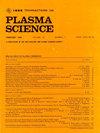A 0-D Electric Gun Model for the Optimization of Flyer Acceleration to Hypervelocities
IF 1.3
4区 物理与天体物理
Q3 PHYSICS, FLUIDS & PLASMAS
引用次数: 1
Abstract
The electric gun is a pulsed power projectile launcher that utilizes the rapid expansion of an ohmically heated exploding foil and electromagnetic (EM) forces to accelerate thin flyers up to 20 km/s. Though the launcher has high energetic efficiencies when compared to alternative techniques, the process of launching flyers above 0.5 mm thickness in this manner often results in uncontrolled launch characteristics and premature failure of the flyer. This behavior is challenging to model numerically, limiting optimization work to sophisticated and computationally intensive magneto-hydrodynamics (MHD) codes. This work presents a 0-D model designed to expedite the parametric optimization process of electric gun loads to launch thick flyers to hypervelocities. The model is capable of predicting not only the foil state and flyer dynamics, but uses a novel approximation to predict the maximum pressure state in the flyer. The model is verified against 3-D MHD Eulerian hydrocode “Code飞片加速至超高速优化的零维电枪模型
电炮是一种脉冲动力发射装置,利用欧姆加热爆炸箔的快速膨胀和电磁(EM)力将薄飞行器加速到20公里/秒。尽管与替代技术相比,发射器具有高能量效率,但以这种方式发射厚度超过0.5毫米的传单的过程通常会导致不受控制的发射特性和传单的过早失效。这种行为很难进行数值模拟,将优化工作限制在复杂且计算密集型的磁流体力学(MHD)代码中。本工作提出了一个0-D模型,旨在加快电枪载荷的参数优化过程,以发射厚传单到超高速。该模型不仅能够预测箔片状态和飞片动力学,而且使用了一种新颖的近似方法来预测飞片内的最大压力状态。用3-D MHD欧拉hydrocode“Code $\mathbb{B}$”对模型进行了验证,并讨论了简化模型所作近似的有效性。有了这个模型,电炮可以被优化,以发射更厚的传单,实现更高的压力和冲击持续时间,使其成为现有弹丸发射平台的补充工具。
本文章由计算机程序翻译,如有差异,请以英文原文为准。
求助全文
约1分钟内获得全文
求助全文
来源期刊

IEEE Transactions on Plasma Science
物理-物理:流体与等离子体
CiteScore
3.00
自引率
20.00%
发文量
538
审稿时长
3.8 months
期刊介绍:
The scope covers all aspects of the theory and application of plasma science. It includes the following areas: magnetohydrodynamics; thermionics and plasma diodes; basic plasma phenomena; gaseous electronics; microwave/plasma interaction; electron, ion, and plasma sources; space plasmas; intense electron and ion beams; laser-plasma interactions; plasma diagnostics; plasma chemistry and processing; solid-state plasmas; plasma heating; plasma for controlled fusion research; high energy density plasmas; industrial/commercial applications of plasma physics; plasma waves and instabilities; and high power microwave and submillimeter wave generation.
 求助内容:
求助内容: 应助结果提醒方式:
应助结果提醒方式:


